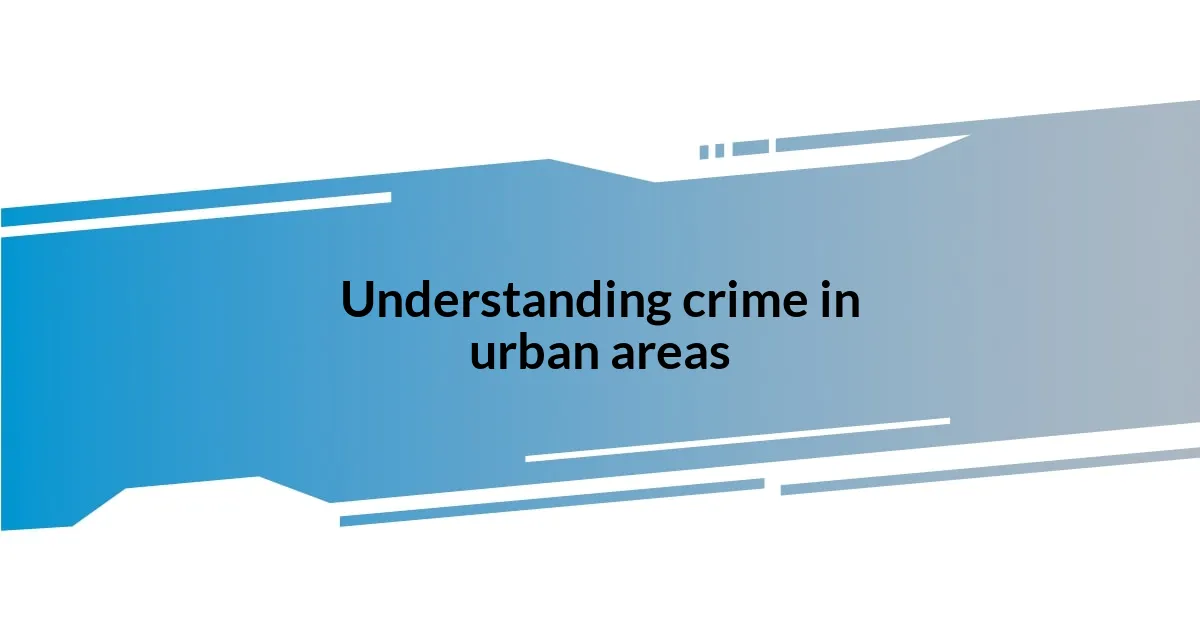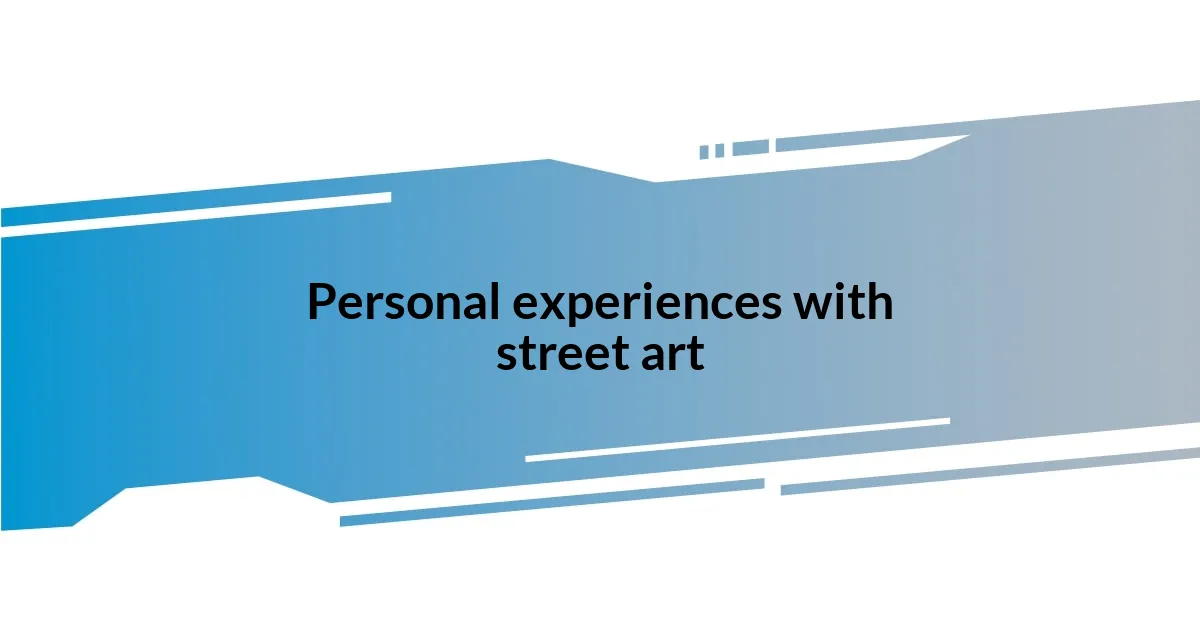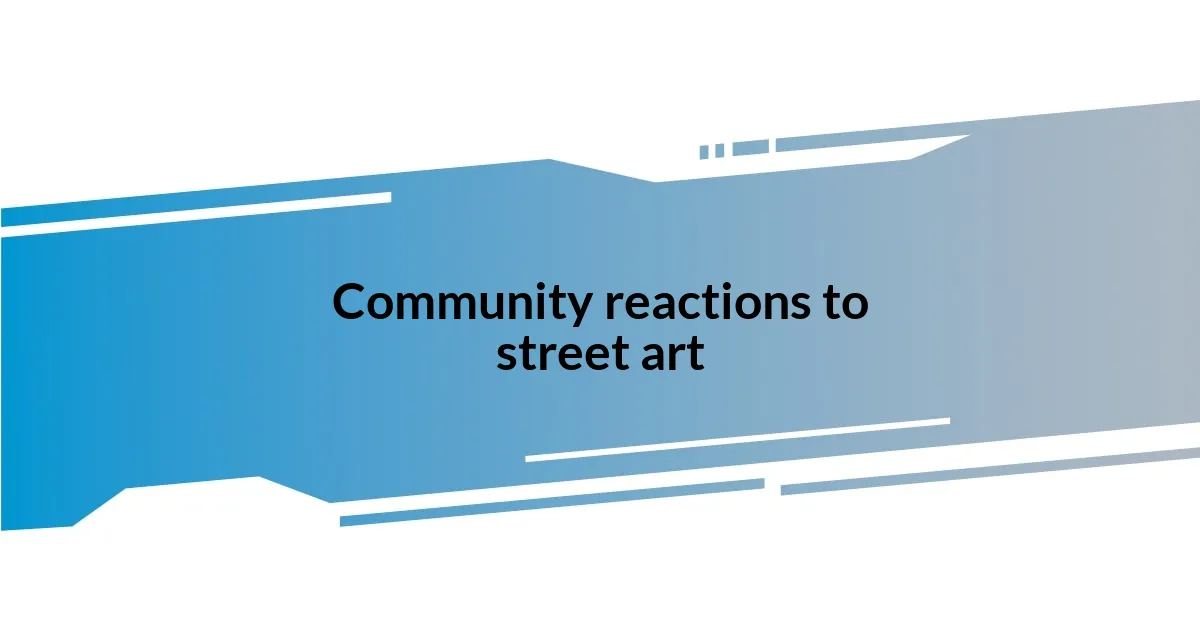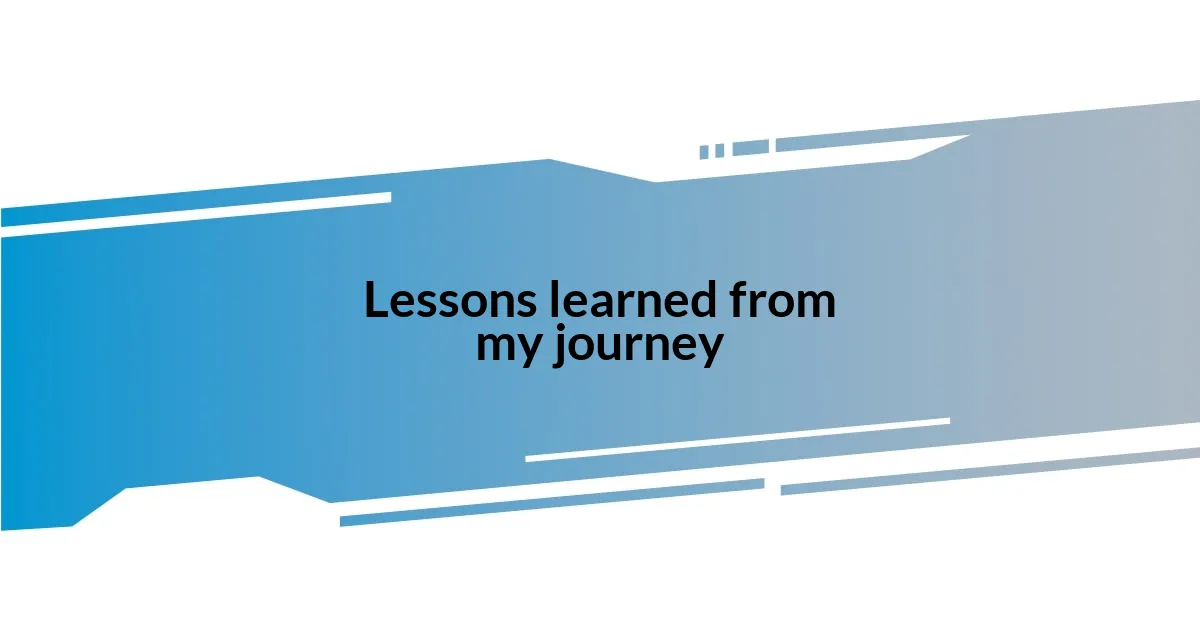Key takeaways:
- Crime thrives in neglected urban spaces influenced by socioeconomic disparities and environmental factors.
- Street art serves as a powerful medium for community expression, remembrance, and dialogue about social issues.
- Community reactions to street art are polarized, reflecting cultural tensions between appreciation and concerns about disorder.
- Engaging with street art can foster resilience and connection, highlighting its potential to inspire change and unity.

Understanding crime in urban areas
Understanding crime in urban areas involves dissecting the intricate relationship between environment and behavior. I remember walking through a once-vibrant neighborhood, now marred by graffiti and decay, and feeling a mix of sadness and anger. How did it come to this? It struck me how crime often thrives in spaces neglected by both society and government.
Many urban areas struggle with socioeconomic disparities that can fuel crime. I’ve seen firsthand how lack of access to quality education and job opportunities can lead individuals down a darker path. It’s heart-wrenching to think that some people feel their only means of survival is through unlawful actions. Can we really blame those who feel they have no other choice?
Moreover, the urban landscape itself plays a role in crime rates. I distinctly recall an alley in my neighborhood that was a hotspot for illegal activity. It was poorly lit and isolated, creating an atmosphere that felt unsafe. Isn’t it fascinating how certain spaces can inadvertently encourage harmful behaviors? In understanding these dynamics, we can begin to see that urban crime is not just an individual issue but a reflection of systemic failures.

Personal experiences with street art
Walking through city streets, I often come across street art that tells a story—sometimes poignant, sometimes raw. I remember stumbling upon a striking mural depicting the struggles of local life, resonating with my experiences in those very neighborhoods. The artist’s style, vivid colors, and impactful message turned a dull wall into a powerful symbol of resilience and expression. It made me think: can art transform a space filled with crime into one that fosters hope?
One evening, I was exploring a quieter part of town when I encountered a series of stencils commemorating victims of violence. As I read the names, an emotional wave washed over me. These weren’t just artistic expressions; they were reminders of lives lost, capturing the pain that often lingers in urban environments. Street art, in this context, became a method of remembrance and a rallying cry for change. It’s incredible how such expressions can bridge the gap between tragedy and awareness.
There was a time when I participated in a community mural project aimed at beautifying a neglected area. Working alongside talented artists and passionate locals, I discovered how creativity unites diverse individuals. That experience underscored for me the idea that street art can breathe life into worn-down spaces, opening doors to conversations about belonging and safety. It becomes a canvas for community dialogue, allowing people to share their truths, hopes, and desires for a better future.
| Aspect | Personal Experience |
|---|---|
| Encounter with a mural | Discovered a mural that turned a dull wall into a vibrant representation of resilience. |
| Emotional stencils | Felt a heavy emotional impact from stencils commemorating victims of violence. |
| Community project | Participated in a mural project that fostered unity and dialogue among diverse local voices. |

Community reactions to street art
I’ve noticed that community reactions to street art can be a mixed bag, often reflecting a deep-seated cultural tension. In one neighborhood where vibrant murals sprang up overnight, some residents celebrated the artistic revival, while others viewed it as vandalism. I distinctly recall a conversation with an older gentleman who felt the murals were a signal of decline. He argued that they replaced traditional values with chaos, highlighting how street art can present divergent views even within a single community. It made me realize that art affects people differently, leading to both appreciation and aversion.
- Celebration of Identity: Many locals embrace street art as a representation of their cultural identity, sparking pride in their neighborhood.
- Concerns about Crime: Some community members associate street art with an increase in crime, fearing it signals neglect and invites more undesirable activities.
- Art as Dialogue: Street art often becomes a conversation starter, allowing residents to voice their opinions and experiences, merging art with activism.
- Generational Divides: Younger residents often advocate for street art as a means of expression, while older generations may view it as a threat to public order.
- Beauty vs. Vandalism: This ongoing debate highlights how perceptions are shaped by individual experiences and the environment itself.
In another instance, during a local festival celebrating street art, I watched as children painted their own interpretations alongside seasoned artists. Laughter and creativity filled the air, and I saw neighbors engaging in conversations about the art around them. This was a beautiful moment, where art crossed barriers and sparked connections among people from different walks of life. The atmosphere was electric, showcasing how street art can be a catalyst for community bonding and healing rather than division. It’s moments like these that remind me of the potential street art has to transform both spaces and hearts.

Lessons learned from my journey
The journey through crime and street art has taught me invaluable lessons about resilience and connection. I vividly recall the day I stood in front of a large mural that depicted a phoenix rising from the ashes. This powerful imagery resonated with my own experiences of overcoming adversity. It was a poignant reminder that, just like that phoenix, we can transform our struggles into something beautiful and uplifting. Have you ever had a moment where art mirrored your own life struggles? I certainly have, and it’s during those times that I felt an unbreakable bond with the art and the community around me.
Engaging with various art pieces made me realize the importance of perspective. I once attended a neighborhood gala where artists shared their stories behind the walls. Listening to them speak about their work was eye-opening. It struck me how each mural held layers of meaning—some expressed joy, while others captured grief. I found myself questioning: how can a single piece of art evoke such a wide array of emotions? This realization deepened my understanding of street art as a living dialogue, a way for people to navigate complex feelings collectively.
Perhaps one of the most profound lessons I learned is that art can ignite change. There was a specific instance when I participated in a forum discussing the impact of street art on local crime rates. The discussions were heated, with some participants protesting against the perceived chaos street art could bring. Yet, I watched others passionately advocate for how it could promote unity and awareness. It was in those discussions that I came to appreciate how art can spark critical conversations and nurture a sense of community. Isn’t it fascinating how creativity can inspire dialogue and even change perceptions? For me, it underscored that art is not just an act of creation; it’s an opportunity for growth and understanding among diverse voices.